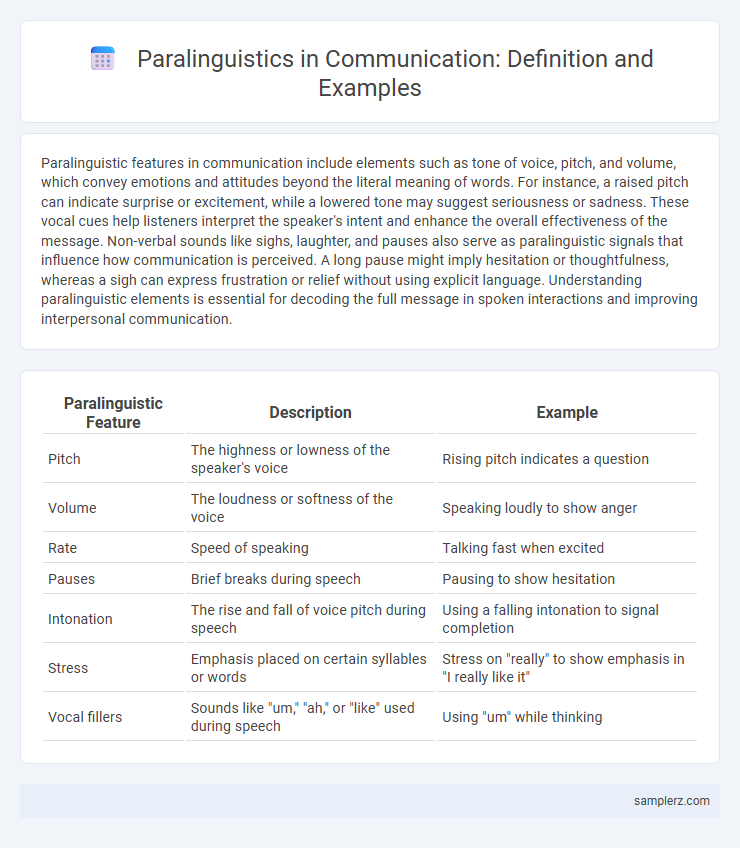Paralinguistic features in communication include elements such as tone of voice, pitch, and volume, which convey emotions and attitudes beyond the literal meaning of words. For instance, a raised pitch can indicate surprise or excitement, while a lowered tone may suggest seriousness or sadness. These vocal cues help listeners interpret the speaker's intent and enhance the overall effectiveness of the message. Non-verbal sounds like sighs, laughter, and pauses also serve as paralinguistic signals that influence how communication is perceived. A long pause might imply hesitation or thoughtfulness, whereas a sigh can express frustration or relief without using explicit language. Understanding paralinguistic elements is essential for decoding the full message in spoken interactions and improving interpersonal communication.
Table of Comparison
| Paralinguistic Feature | Description | Example |
|---|---|---|
| Pitch | The highness or lowness of the speaker's voice | Rising pitch indicates a question |
| Volume | The loudness or softness of the voice | Speaking loudly to show anger |
| Rate | Speed of speaking | Talking fast when excited |
| Pauses | Brief breaks during speech | Pausing to show hesitation |
| Intonation | The rise and fall of voice pitch during speech | Using a falling intonation to signal completion |
| Stress | Emphasis placed on certain syllables or words | Stress on "really" to show emphasis in "I really like it" |
| Vocal fillers | Sounds like "um," "ah," or "like" used during speech | Using "um" while thinking |
Understanding Paralinguistics in Everyday Communication
Paralinguistics includes vocal elements such as tone, pitch, volume, and speech rate that convey emotions and attitudes beyond spoken words. These non-verbal cues play a crucial role in interpreting the speaker's intent and enhancing message clarity in everyday communication. Understanding paralinguistics improves interpersonal interactions by revealing underlying emotions and reinforcing verbal messages.
The Role of Tone and Pitch in Conveying Meaning
Tone and pitch play a critical role in paralinguistic communication by influencing emotional perception and intent behind spoken words. Variations in pitch can signal questions, excitement, or seriousness, while tone conveys attitudes such as sarcasm, anger, or empathy without changing the actual words. These vocal elements enhance message clarity and help listeners interpret the speaker's true feelings and intentions effectively.
Volume and Its Impact on Message Interpretation
Volume significantly influences message interpretation by conveying emotions such as anger, excitement, or calmness. Speaking loudly can emphasize urgency or authority, while a softer volume often signals intimacy or confidentiality. Understanding these vocal cues enhances effective communication and reduces misunderstandings.
The Significance of Speech Rate in Social Interactions
Speech rate significantly influences social interactions by conveying emotions and attitudes beyond words. Rapid speech often indicates excitement or urgency, while slower speech can suggest thoughtfulness or seriousness. Understanding these paralinguistic cues enhances effective communication and helps interpret the speaker's underlying intentions.
Pauses: Adding Emphasis and Intent in Conversations
Pauses in communication serve as crucial paralinguistic cues that enhance message clarity and emotional impact by signaling emphasis or intent. Strategic timing of pauses can highlight important points, allowing listeners to process information more effectively and encouraging engagement. These deliberate silences convey confidence, hesitation, or reflection, adding depth to verbal exchanges and improving overall conversational dynamics.
Vocal Quality and Emotional Expression
Vocal quality, such as tone, pitch, and volume, plays a crucial role in conveying emotions during communication. Variations in these vocal elements can express feelings like anger, happiness, or sadness without the need for words. Emotional expression through paralinguistic cues enhances understanding and connection between speakers by adding depth to the spoken message.
Laughter, Sighs, and Other Nonverbal Vocal Cues
Laughter, sighs, and other nonverbal vocal cues play a critical role in paralinguistic communication by conveying emotions and attitudes beyond spoken words. Laughter signals amusement or bonding, while sighs often express frustration, relief, or exhaustion, adding emotional depth to interactions. These vocalizations enhance message interpretation and help regulate conversational flow, making them essential components of effective communication.
The Influence of Accent on Perceived Communication
The influence of accent significantly shapes perceived communication by affecting how messages are interpreted beyond the literal words. Variations in pitch, tone, and stress patterns linked to specific regional or social accents convey emotions and attitudes that impact listener understanding and engagement. Accent subtly signals identity and cultural background, which can enhance or hinder effective communication depending on the listener's familiarity and biases.
Paralinguistic Cues in Digital Communication
Paralinguistic cues in digital communication include elements such as emojis, punctuation, and text formatting, which convey tone and emotion beyond the words themselves. For instance, the use of exclamation marks or capital letters can indicate excitement or urgency, while emojis provide visual context that clarifies intent. These non-verbal signals play a crucial role in interpreting messages accurately in text-based interactions like emails, chats, and social media.
Cross-Cultural Differences in Paralinguistic Signals
Paralinguistic signals, such as intonation, pitch, and speech rate, vary significantly across cultures, influencing communication effectiveness and interpretation. For instance, a high pitch may indicate excitement in Western cultures but express anxiety or disrespect in some Asian cultures. Understanding these cross-cultural differences in paralinguistics helps prevent misunderstandings and enhances interpersonal communication in diverse settings.

example of paralinguistic in communication Infographic
 samplerz.com
samplerz.com